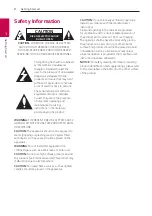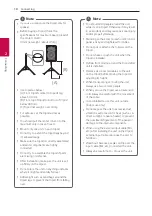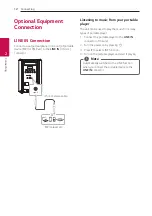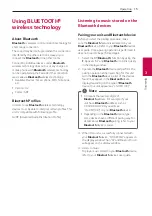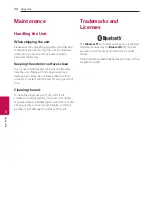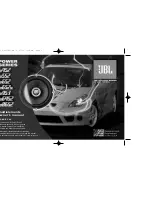
3
Operating
Operating
14
Oper
ating
3
Basic Operations
USB/SD Operations
Connect the USB device to the USB port. Or connect
the SD card to the
SD CARD
slot. When you connect
the USB device or SD card, the player plays an
audio file contained in the USB / SD storage device
automatically.
To
Do this
Playback
Press
N
.
Pause
Press
N
during playback.
Skipping to
the next/
previous file
Press
V
to go to the next file.
Playing less than 4 seconds,
Press
C
to go to the previous file.
Playing after 4 seconds, press
C
to go to the beginning of the file.
Playing
repeatedly
Press
REPEAT
repeatedly.
ONE <-> ALL
y
Do not extract the USB device or SD card
during operation. (play, etc.)
y
Regular back up is recommended to prevent
data loss.
y
If the USB device and SD card is connected
to the unit at the same time, use the unit by
changing a function.
y
The resume point may be cleared when in the
cases below.
-
Turning off the unit.
-
Removing the USB device or SD card from
the unit.
-
Pulling out the power cord.
-
Changing to a function.
y
When you press and hold
C
/
V
, you can
move to a folder and play a first song in the
folder. Also you can skip to the next folder
when you press
C
/
V
button within a
certain period of time.
,
Note
y
Files are recognized as below.
*
y
Folders will be presented as the following
order;
ROOT FOLDER 1 FOLDER 3
FOLDER 7 FOLDER 8 FOLDER 5
FOLDER 6
y
File will be played from
$
file No.1 to
$
file
No.14 one by one.
y
Files will be presented in order recorded and
may be presented differently according to the
record circumstances.
y
In case of the folder name, only numbers
are supported. (The other characters are
displayed as “_”.).
*ROOT : The first screen you can see when
a computer recognize the USB / SD card are
“ROOT”
,
Note
Summary of Contents for RM1
Page 21: ......


